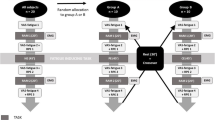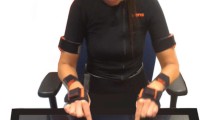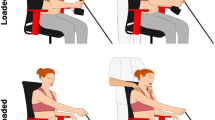Abstract
Physiological tremors within a limb are coupled, whereas between-limb tremors are thought to oscillate independently for a healthy subject. This study was undertaken to reinvestigate bilateral tremor relations and intra-limb tremor dynamics for a two-limb task after exhausting a single joint. Fifteen volunteers conducted prolonged tracking with the left (target) shoulder. Neuromuscular functions were monitored before and after the exercise-fatiguing intervention, including tracking displacement, muscle activity of the deltoid, and physiological tremors in the bilateral upper limbs. Localized fatiguing contraction degraded tracking accuracy and movement smoothness, accompanied by an increase in deltoid activation. Segment tremors in the bilateral limbs and inter-limb tremor coherences in 8–12 Hz increased, though coherence peaks in 5–8 Hz waned with fatigue response. Intra-limb tremor relations in the target and non-target limbs were also reorganized with unilateral fatiguing contraction. Tremor coupling in the arm-C7 complexes was enhanced, associated with tremor uncoupling in the forearm–arm and hand–forearm complexes. Tracking error in the pre- fatigue and post-fatigue conditions was predicted by different principal components that had high communalities with tremors of distal and proximal segments of the target limb, respectively. The adaptive changes in tremor dynamics were attributable to fatigue-induced enhancement of common central drive and decline in neural inputs of long-looped reflexes that diverge to contralateral segments.








Similar content being viewed by others
References
Addamo PK, Farrow M, Hoy KE et al (2007) The effects of age and attention on motor overflow production—a review. Brain Res Rev 54:189–204
Arihara M, Sakamoto K (1999) Contribution of motor unit activity enhanced by acute fatigue to physiological tremor of finger. Electromyogr Clin Neurophysiol 39:235–247
Armatas CA, Summers JJ, Bradshaw JL (1996) Handedness and performance variability as factors influencing mirror movement occurrence. J Clin Exp Neuropsychol 18:823–835
Barnes GR, Asselman PT (1991) The mechanism of prediction in human smooth pursuit eye movements. J Physiol 439:439–461
Boonstra TW, Daffertshofer A, van Ditshuizen JC et al (2008) Fatigue-related changes in motor-unit synchronization of quadriceps muscles within and across legs. J Electromyogr Kinesiol 18:717–731
Boonstra TW, van Wijk BC, Praamstra P, Daffertshofer A (2009) Corticomuscular and bilateral EMG coherence reflect distinct aspects of neural synchronization. Neurosci Lett 463:17–21
Côté JN, Mathieu PA, Levin MF et al (2002) Movement reorganization to compensate for fatigue during sawing. Exp Brain Res 146:394–398
Elble RJ (1996) Central mechanisms of tremor. J Clin Neurophysiol 13:133–144
Enoka RM, Duchateau J (2008) Muscle fatigue: what, why and how it influences muscle function. J Physiol 586:11–23
Farmer SF, Sheean GL, Mayston MJ et al (1998) Abnormal motor unit synchronization of antagonist muscles underlies pathological co-contraction in upper limb dystonia. Brain 121:801–814
Fellows SJ, Töpper R, Schwarz M et al (1996) Stretch reflexes of the proximal arm in a patient with mirror movements: absence of bilateral long-latency components. Electroencephalogr Clin Neurophysiol 101:79–83
Gandevia SC (2001) Spinal and supraspinal factors in human muscle fatigue. Physiol Rev 81:1725–1789
Gribble PL, Mullin LI, Cothros N et al (2003) Role of cocontraction in arm movement accuracy. J Neurophysiol 89:2396–2405
Grosse P, Brown P (2003) Acoustic startle evokes bilaterally synchronous oscillatory EMG activity in the healthy human. J Neurophysiol 90:1654–1661
Hägg GM (1992) Interpretation of EMG spectral alterations and alteration indexes at sustained contraction. J Appl Physiol 73:1211–1217
Hogan N, Flash T (1987) Moving gracefully quantitative theories of motor coordination. Trends Neurosci 10:170–174
Hoy KE, Fitzgerald PB, Bradshaw JL et al (2004) Investigating the cortical origins of motor overflow. Brain Res Brain Res Rev 46:315–327
Huang CT, Hwang IS, Huang CC et al (2006) Exertion dependent alternations in force fluctuation and limb acceleration during sustained fatiguing contraction. Eur J Appl Physiol 97:362–371
Huang CT, Huang CC, Young MS et al (2007) Age effect on fatigue-induced limb acceleration as a consequence of high-level sustained submaximal contraction. Eur J Appl Physiol 100:675–683
Huffenus AF, Amarantini D, Forestier N (2006) Effects of distal and proximal arm muscles fatigue on multi-joint movement organization. Exp Brain Res 170:438–447
Hwang IS, Abraham LD (2001) Quantitative EMG analysis to investigate synergistic coactivation of ankle and knee muscles during isokinetic ankle movement. Part 1: time amplitude analysis. J Electromyogr Kinesiol 11:319–325
Hwang IS, Wu PS (2006) The reorganization of tremulous movements in the upper limb due to finger tracking maneuvers. Eur J Appl Physiol 98:191–201
Hwang IS, Chen YC, Wu PS (2009a) Differential load impact upon arm tremor dynamics and coordinative strategy between postural holding and position tracking. Eur J Appl Physiol 105:945–957
Hwang IS, Yang ZR, Huang CT et al (2009b) Reorganization of multidigit physiological tremors after repetitive contractions of a single finger. J Appl Physiol 106:966–974
Kurtzer IL, Pruszynski JA, Scott SH (2008) Long-latency reflexes of the human arm reflect an internal model of limb dynamics. Curr Biol 18:449–453
Liang N, Murakami T, Funase K et al (2008) Further evidence for excitability changes in human primary motor cortex during ipsilateral voluntary contractions. Neurosci Lett 433:135–140
Legros A, Marshall HR, Beuter A et al (2010) Effects of acute hypoxia on postural and kinetic tremor. Eur J Appl Physiol 110:109–119
Masuda K, Masuda T, Sadoyama T et al (1999) Changes in surface EMG parameters during static and dynamic fatiguing contractions. J Electromyogr Kinesiol 9:39–46
Marsden CD, Meadows JC, Lange GW et al (1969) The relation between physiological tremor of the two hands in healthy subjects. Electroencephalogr Clin Neurophysiol 27:179–185
Marsden JF, Brown P, Salenius S (2001) Involvement of the sensorimotor cortex in physiological force and action tremor. Neuroreport 12:1937–1941
McAuley JH, Farmer SF, Rothwell JC et al (1999) Common 3 and 10 Hz oscillations modulate human eye and finger movements while they simultaneously track a visual target. J Physiol 515:905–917
McAuley JH, Marsden CD (2000) Physiological and pathological tremors and rhythmic central motor control. Brain 123:1545–1567
MacKay WA, Kwan HC, Murphy JT et al (1983) Stretch reflex modulation during a cyclic elbow movement. Electroencephalogr Clin Neurophysiol 55:687–698
Missenard O, Mottet D, Perrey S (2008) The role of cocontraction in the impairment of movement accuracy with fatigue. Exp Brain Res 185:151–156
Missenard O, Mottet D, Perrey S (2009) Adaptation of motor behavior to preserve task success in the presence of muscle fatigue. Neuroscience 161:773–786
Morrison S, Newell KM (1996) Inter- and intra-limb coordination in arm tremor. Exp Brain Res 110:455–464
Morrison S, Newell KM (1999) Bilateral organization of physiological tremor in the upper limb. Eur J Appl Physiol Occup Physiol 80:564–574
Morrison S, Newell KM (2000) Postural and resting tremor in the upper limb. Clin Neurophysiol 111:651–663
Morrison S, Kavanagh J, Obst SJ et al (2005) The effects of unilateral muscle fatigue on bilateral physiological tremor. Exp Brain Res 167:609–621
Morrison S, Sosnoff JJ (2010) The impact of localized fatigue on contralateral tremor and muscle activity is exacerbated by standing posture. J Electromyogr Kinesiol 20:1211–1218
Navas F, Stark L (1968) Sampling or intermittency in hand control system dynamics. Biophys J 8:252–302
Ohki Y, Johansson RS (1999) Sensorimotor interactions between pairs of fingers in bimanual and unimanual manipulative tasks. Exp Brain Res 127:43–53
Pedersen J, Ljubisavljevic M, Bergenheim M et al (1998) Alterations in information transmission in ensembles of primary muscle spindle afferents after muscle fatigue in heteronymous muscle. Neuroscience 84:953–959
Post M, Bayrak S, Kernell D et al (2008) Contralateral muscle activity and fatigue in the human first dorsal interosseous muscle. J Appl Physiol 105:70–82
Reynolds R, Lakie M (2010) Postmovement changes in the frequency and amplitude of physiological tremor despite unchanged neural output. J Neurophysiol 104:2020–2023
Soechting JF, Lacquaniti F (1988) Quantitative evaluation of the electromyographic responses to multidirectional load perturbations of the human arm. J Neurophysiol 59:1296–1313
Selen LP, van Dieën JH, Beek PJ (2006) Impedance modulation and feedback corrections in tracking targets of variable size and frequency. J Neurophysiol 96:2750–2759
Semmler JG, Tucker KJ, Allen TJ et al (2007) Eccentric exercise increases EMG amplitude and force fluctuations during submaximal contractions of elbow flexor muscles. J Appl Physiol 103:979–989
Tang WT, Zhang WY, Huang CC et al (2008) Postural tremor and control of the upper limb in air pistol shooters. J Sports Sci 26:1579–1587
Todd G, Petersen NT, Taylor JL et al (2003) The effect of a contralateral contraction on maximal voluntary activation and central fatigue in elbow flexor muscles. Exp Brain Res 150:308–313
Vaillancourt DE, Newell KM (2000) Amplitude changes in the 8–12, 20–25, and 40 Hz oscillations in finger tremor. Clin Neurophysiol 111:1792–1801
Vallbo AB, Wessberg J (1993) Organization of motor output in slow finger movements in man. J Physiol 469:673–691
Wessberg J, Vallbo AB (1995) Coding of pulsatile motor output by human muscle afferents during slow finger movements. J Physiol 485:271–282
Wing AM, Kristoffersen AB (1973) The timing of interresponse interval. Percept Psychophys 13:455–460
Zijdewind I, Kernell D (2001) Bilateral interactions during contractions of intrinsic hand muscles. J Neurophysiol 85:1907–1913
Acknowledgments
This research was supported in part by a grant from the National Science Council, R.O.C., under Grant No. NSC-94-2314-B-006-026.
Author information
Authors and Affiliations
Corresponding author
Additional information
Communicated by Fausto Baldissera.
Rights and permissions
About this article
Cite this article
Chen, YC., Yang, JF. & Hwang, IS. Global effect on multi-segment physiological tremors due to localized fatiguing contraction. Eur J Appl Physiol 112, 899–910 (2012). https://doi.org/10.1007/s00421-011-2044-7
Received:
Accepted:
Published:
Issue Date:
DOI: https://doi.org/10.1007/s00421-011-2044-7




